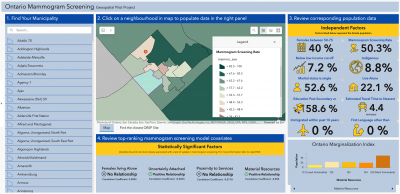Place-Based Analysis to Understand Health Seeking Behavior
Presentation to Central OHT Collaborative June 13, 2024.
The link between communities, places, and health is well-established in the scientific and public health literature. Differences in the characteristics of places can help explain differences in health inequalities. Place-based analysis offers a lends to better understand the health needs of local communities, evaluate gaps in health service accessibility, and show where opportunities to intervene exist. Access to care should not be determined by where people live.

As part of our collaboration between the Northern York, South Simcoe Ontario Health Team and ESRI Canada‘s Public Health team, we presented to representatives of Ontario Health Teams from across the province. This work demonstrates a pilot project for our place-based geographic analysis of the factors influencing mammography screening at the local level, and builds on our prior collaborations.
The objective of this project was to see how geoanalytic results can be used in health system planning and point-of-care, with the goal of improving the health of local populations. For this project, the mammography screening use-case makes use of existing data that can be integrated with local-level data on social determinants and health accessibility. Building from our prior work with geographically weighted regression, this project facilitated the creation of an interactive geospatial visualization tool to provide OHTs a resource for developing upstream engagement strategies.
The project demonstrated how a data-centred, place-based approach enhances understanding of an OHT’s attributable population.
The mammography screening interactive tool is available online.